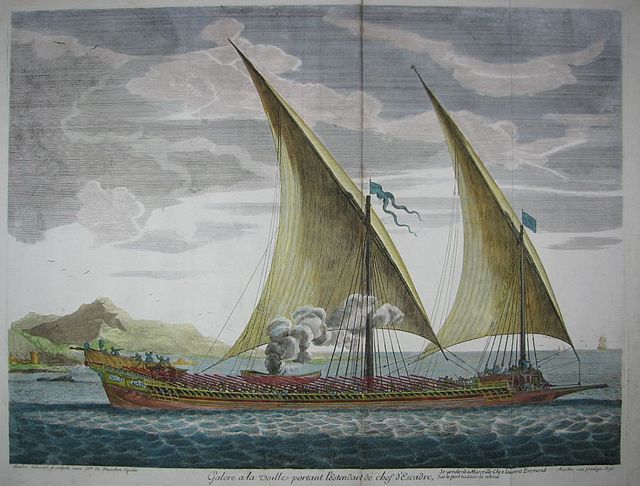A trireme was an ancient vessel and a type of galley that was used by the ancient maritime civilizations of the Mediterranean Sea, especially the Phoenicians, ancient Greeks and Romans.
Fleet of triremes made up of photographs of the modern full-sized replica Olympias
Phoenician warship with two rows of oars, relief from Nineveh, c. 700 BC
The Lenormant Relief, from the Athenian Acropolis, depicting the rowers of an aphract Athenian trireme, c. 410 BC. Found in 1852, it is one of the main pictorial testaments to the layout of the trireme.
A Greek trireme
A galley was a type of ship which relied mostly on oars for propulsion that was used for warfare, trade, and piracy mostly in the seas surrounding Europe. It developed in the Mediterranean world during antiquity and continued to exist in various forms until the early 19th century. It typically had a long, slender hull, shallow draft, and often a low freeboard. Most types of galleys also had sails that could be used in favourable winds, but they relied primarily on oars to move independently of winds and currents. The term "galley" originated from a Greek term for a small type of galley and came in use in English from about 1300. It has occasionally been used for unrelated vessels with similar military functions as galley but which were not Mediterranean in origin, such as medieval Scandinavian longships, 16th-century Acehnese ghalis and 18th-century North American gunboats.

Colourised engraving of a French galley (27 pairs of oars) built according to the design that was standard in the Mediterranean from the early 17th century; Henri Sbonski de Passebon, 1690
United States ships at the Battle of Valcour Island depicting several "row galleys" similar in function but based on very different designs from Mediterranean galleys; watercolor by Charles Randle
Drawing of warships (pointed bows) and trade ships (rounded bows); based on a wall relief from the Southwest Palace at Nineveh, circa 700 BC.
Two compact liburnians used by the Romans in the campaigns against the Dacians in the early 2nd century AD; relief from Trajan's Column, c. 113 AD








